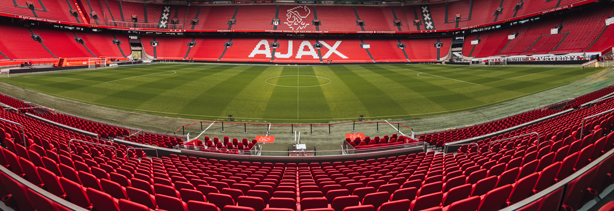The Johan Cruijff ArenA is not only one of the most innovative stadiums in the world by design, it also serves as a platform for innovation with its ecosystem. Together with its partners Microsoft and Holland Innovative, they developed a state-of-the-art pitch platform, continuously monitoring the grass conditions and translating this data into insights for daily operations. This technology improved the quality of the pitch significantly while using less resources. The pitch platform is Internet of Things in practice and shows a lot of scaling potential towards other stadiums, other buildings (like smart housing), cities and other sectors. However, implementing an innovation like this takes a lot of work, and often requires the need to work with partners. This use case serves as an inspiration, as it is one of the most practical examples of the Internet of Things that shows the scalability potential of the technology.
Introduction
Johan Cruijff ArenA is the home base of Ajax and the Dutch national soccer team. An iconic location for events and concerts. Unforgettable experiences happen in the Johan Cruijff ArenA. But the ArenA is more than just a stadium. The ArenA is developing innovation concepts in a field lab to make stadiums and cities worldwide smarter and more sustainable.
They believe that innovation makes all the difference. In Amsterdam South-East, the stadium and its founding partners created an innovation platform to test and grow solutions for societal and business challenges in the field of mobility, crowd control, security, fan experience, sustainability, open platform collaboration and citizen wellbeing. Innovations built on the newest technologies are made visible for more than 2 million yearly visitors of the stadium and in the area. The ArenA serves as an example to put technological innovation in practice and showcase its possibilities. One of KPMG’s roles in the Johan Cruijff ArenA is to facilitate the process and connect the right partners to accelerate innovation.
One of the most visible and appealing innovations regarding the Internet of Things at Johan Cruijff ArenA, is probably the pitch platform and dashboard. Although IoT innovations sometimes seem rather mysterious, the pitch platform is a very tangible example of how state-of-the-art technology is directly adding value: it’s a hands-on solution, enabling the pitch to be in its best shape. But this digital twin of the pitch was only possible through close collaboration with partners. In this article we dive into the collaborative aspects of innovation. As Henk Markerink, CEO of the Johan Cruijff ArenA points out: “Alone you go faster, but in collaboration you go further.”
Johan Cruijff ArenA as a collaborative innovation ecosystem
The Johan Cruijff ArenA collaborates with corporate partners and Small and Medium-sized Enterprises (SMEs) as well as research institutions to gather more knowledge and create a vibrant ecosystem where innovation thrives. From the very beginning, collaboration proved to be key in enabling innovation. In 2015, the Johan Cruijff ArenA Innovation center was officially launched, providing a network of partners to enable innovation. Partners are invited to experiment, test and develop their newest innovations in the Johan Cruijff ArenA that serves as a field lab. The learnings from these validations are of great value for the further commercialization and scaling of the innovations.
This acceleration of speed due to collaboration is also seen in Internet of Things solutions within ArenA. Within the innovation center, partners innovate together in the field of smart building and smart city. Collaboration is again key for innovation, especially for smart city applications as this requires a system approach rather than the implementation of separate systems. Integrating and analyzing great amounts of data to be able to leverage its value is only possible when multiple stakeholders come together. The most famous example of Internet of Things technology within the Johan Cruijff ArenA is undoubtedly the smart pitch: as the first stadium, the Johan Cruijff ArenA has created a system to make its grass connected and smart using sensors, data, analytics and dashboarding.
IoT in practice: the smart grass of the ArenA
The need for smarter grass was evident: the grass in the Johan Cruijff ArenA was heavily criticized by players and fans since its opening almost 25 years ago. Taking good care of a pitch in a stadium is a true challenge: the stands are obstructing the sunlight to come in, the Dutch weather is unpredictable and most of the matches take place during the time the grass isn’t growing or hardly grows. Paul Baas is Field Manager of Johan Cruijff ArenA: “Our biggest challenge is the lack of air flows in a stadium and the lack of natural lights. Also, the ArenA grass has a busy schedule: a huge number of soccer matches and other events take place during the year. After each event, we need to know exactly what damage is done where so we can quickly respond.”
In line with the collaborative innovation school of thought the Johan Cruijff ArenA has embraced, Microsoft and Holland Innovative joined forces in developing a state-of-the-art pitch dashboard (see https://www.youtube.com/watch?v=hB-XjPP4j3Y) to enable this better monitoring.
Figure 1. Dashboard (still from https://www.youtube.com/watch?v=hB-XjPP4j3Y).
Figure 2. The high-tech pitch platform at the Johan Cruijff ArenA. [Click on the image for a larger image]
Its high-tech system built on Microsoft Azure monitors the grass continuously using 40 sensors located in the grass as well as on the roof. These sensors measure temperature, light, humidity of soil and air, wind speed, rainfall, and the amount of salts and minerals present in the soil. A weather station is placed on the field, a couple of them right under the rooftop. Besides this data, other performance measures are taken, such as measuring the speed of the ball, the degree of the bouncing ball, the hardness or smoothness of the field and the rooting. This data is brought together visually in the Microsoft PowerBI dashboard, where the “grass team” gets an overview of the real-time climate and exact status of the grass in the different areas of the field. In the dashboard, an overview of the pitch is shown: green areas show parts of the grass in good condition, orange parts are at risk, but the red zones show the critical zones. This clear visualization translates the information from the office to the grass team and technical staff. Paul Baas: “The dashboard visualizes which parts of the pitch are used less frequently during the match, enabling us to adapt the maintenance to help the pitch recover better and faster. What is also very interesting, is that it helps us make predictions about what the pitch will look like in the future, for example during the European Championships or dance events. We can determine our treatment plan for the grass, and with the dashboard we can get an impression of what would be the impact of our actions for the grass. We’re obviously dealing with nature and therefore take into account an uncertainty margin, but the dashboard does help us make better decisions.” A moment where this decision was of major importance, happened a couple of weeks before a potential large-scale dance event. When the request to host an extra event came in during the soccer season, the conditions of the grass were decisive for the final Go or No-Go of this event.
Based on this information, the grass team can also adjust the way they are taking care of the different zones of the field. If for example it is known that the coming days the weather will be warm, the team knows they should close the roof (Johan Cruijff ArenA has a moveable rooftop), to prevent and reduce stress for the plants caused by too much light. Also, in case of a heatwave, it has happened that the field had to be equipped with cooling systems to prevent the grass from getting too hot. The type of grass at Johan Cruijff ArenA is called “cold-season grass”, which only thrives under a temperature of 23 degrees Celsius. Based on the measured amount of light, the grass team gets “light advice” on where to place the pitch heat lamps. The grass team works with a variety of lamps that influence the growth and development of the plant positively: some types of lights influence the roots of the plant positively, whereas other types of lights increase the quality of the leaves. The results are stunning: the quality of the grass (for more information, see the box below) increased with 20% since its implementation, while the costs for field maintenance are lower and the energy consumption decreased.
The quality of the grass is measured and therefore quantifiable based on two components: vitality and grass occupation.
Vitality = the growth ability, or the ability to recover after a match so that the turf returns to its old level more quickly, is more resistant to diseases and looks vital.
Grass occupation = the amount of grass in a particular area. This is relevant for certain playing characteristics of the field, and the field also looks better.
The pitch dashboard basically functions as a digital twin (a data-driven representation of the true physical world) of the grass. Paul Baas: “The quality of the pitch is subjective and can vary from player to player. Back in the day, someone would just walk on the field and visually assess the quality and amount of grass. This assessment is also subjective as it always needs a relative point. If you would rate the grass a 9 in the winter, it is objectively seen as a lower quality compared to a rating of a 9 in summer. However, with this dashboard we try to objectivize this quality, to remove the ‘gut feeling test’. In my field of expertise, I believe I have a dream job. ArenA currently has the highest quality pitch possible. Taking into account my passion for grass, this place is this highest achievable within the Netherlands for sure.” Every time the grass is mowed, an automatic ‘crop scan’ is carried out. During mowing, two sensors register the number of leaves and the conditions and how it grows. Because we’ve been doing this for several years now, it is possible to compare the outcomes with a benchmark that is becoming more precise after each measurement. “In this way, we can respond to what is truly happening, we do not have to rely on protocols; we are truly data driven. When Ajax loses a match in the ArenA, people used to blame it on the (bad) pitch quality. But when Ajax won a match, it was also attributed to the pitch quality. We have removed this subjective aspect and made it fact based.”
Figure 3. Players’ feedback is valuable input for the quality of the pitch, but is very subjective. [Click on the image for a larger image]
Scaling the technology to other pitches and beyond
This technology caught a lot of national and international attention. The Dutch soccer association KNVB showed great interest from the start of the development and implemented the system for its training pitches for the Dutch national soccer team. The ambition is to scale this technology for other professional leagues as well. For Holland Innovative it is clear that, although ArenA is a frontrunner in this field, there still is another ultimate goal: a light ceiling. Instead of using different lights on the field, we will have an installation coming from the ceiling. This new technology provides a better quality of light and better doses the light, enabling an even more precise and potentially automated treatment.
Figure 4. The pitch of Johan Cruijff ArenA. [Click on the image for a larger image]
However specific this technology may sound, it shows tremendous scaling potential for other smart stadiums and smart city applications. The robust technology translating the data into actionable insights can, for instance, be used in agriculture, providing a digital twin of crops and seeds, as well as smart buildings (like housing and offices) and cities providing the insights for urban development and decision-making, such as for real estate. By predicting the effect of different designs, this technology can also provide support when deciding on where to plant trees and realize green in cities for example. There are also scaling possibilities for the health sector where data can assist medical staff and ensure a healthy environment. The possibilities are endless.
Holland Innovative: “I think that what we do at Johan Cruijff ArenA provides a true learning environment, a living lab for different sectors. Looking at the technology, we learned how to do it in the right way, we could copy this directly to other situations. The knowledge we gained is also useful for countries where it is more challenging to grow crops for instance.”
While scaling the platform outside the stadium, the ArenA is continuously developing an even smarter pitch. Henk van Raan, Chief Innovation Officer of Johan Cruijff ArenA has high ambitions: “We now know exactly how the grass ‘feels’. It is my dream that one day the grass will tell you itself how it’s doing. It shouldn’t be me telling someone that the field is fine. How great would it be if the grass itself is able to say that it is ready for the match between Ajax and Real Madrid?”
Conclusion
Over the last decades we have seen a rapid increase in embracing innovation as a way to drive value for organizations. Innovation can be a driver for business, brand and culture value. It offers benefits in business value ranging from top-line growth to bottom-line savings. Brand value is created because you show investors, potential employees and the press how innovation can increase the perceived value of your organization and help you in the war for talent. Lastly, innovation creates value for your organizational culture as it allows your employees to be engaged in innovation, which will greatly stimulate their commitment and ownership. More and more organizations realize that innovation is teamwork. We see a growing number of open innovation programs aimed at startups, venture programs and ecosystems popping up all over the world.
The Johan Cruijff ArenA has managed to build an ecosystem that builds on the best of both worlds: large open innovation programs at frequent intervals, SME and corporate partners, a living lab to test and implement and an international network to scale. The development of the digital twin of the pitch is a great example of a successful combination of Internet of Things technology, the right partners, and applying an agile way of working towards the implementation. The pitch platform also serves as a blueprint to quickly add to the range of IoT tools they have at the Johan Cruijff ArenA and is a great example of the scalability of a very specific solution when applying the Internet of Things in practice.
KPMG advises and supports the innovation center of the Johan Cruijff ArenA through growing and activating its ecosystem of corporates and scale-ups to accelerate innovation. If you would like to know more about the collaborative ecosystem or innovations at Johan Cruijff ArenA, we encourage you to contact the authors of this article.









